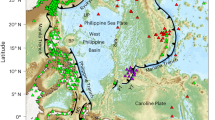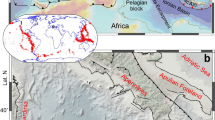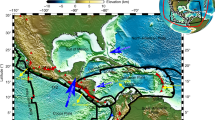Abstract
Seismic anisotropy is a powerful tool for detecting the geometry and style of deformation in the Earth’s interior, as it primarily reflects the deformation-induced preferred orientation of anisotropic crystals1,2. Although seismic anisotropy in the upper mantle is generally attributed to the crystal-preferred orientation of olivine3, the strong trench-parallel anisotropy (delay time of one to two seconds) observed in several subduction systems4,5 is difficult to explain in terms of olivine anisotropy, even if the entire mantle wedge were to act as an anisotropic source. Here we show that the crystal-preferred orientation of serpentine, the main hydrous mineral in the upper mantle, can produce the strong trench-parallel seismic anisotropy observed in subduction systems. High-pressure deformation experiments reveal that the serpentine c-axis tends to rotate to an orientation normal to the shear plane during deformation; consequently, seismic velocity propagating normal to the shear plane (plate interface) is much slower than that in other directions. The seismic anisotropy estimated for deformed serpentine aggregates is an order of magnitude greater than that for olivine6, and therefore the alignment of serpentine in the hydrated mantle wedge results in a strong trench-parallel seismic anisotropy in the case of a steeply subducting slab. This hypothesis is also consistent with the presence of a hydrous phase in the mantle wedge, as inferred from anomalously low seismic-wave velocities7.
This is a preview of subscription content, access via your institution
Access options
Subscribe to this journal
Receive 51 print issues and online access
$199.00 per year
only $3.90 per issue
Buy this article
- Purchase on Springer Link
- Instant access to full article PDF
Prices may be subject to local taxes which are calculated during checkout




Similar content being viewed by others
References
Nicolas, A. & Christensen, N. I. in Composition, Structure and Dynamics of the Lithosphere-Asthenosphere System (eds Fuchs, K. & Froideveaux, C.) 407–433 (American Geophysical Union, 1987)
Long, M. D. & Silver, P. G. The subduction zone flow field from seismic anisotropy: a global view. Science 319, 315–318 (2008)
Zhang, S. & Karato, S. Lattice preferred orientation of olivine aggregates deformed in simple shear. Nature 375, 774–777 (1995)
Long, M. D. & van der Hilst, R. D. Shear wave splitting from local events beneath the Ryukyu arc: trench-parallel anisotropy in the mantle wedge. Phys. Earth Planet. Inter. 155, 300–312 (2006)
Smith, G. P. et al. A complex pattern of mantle flow in the Lau backarc. Science 292, 713–716 (2001)
Katayama, I. & Karato, S. Effect of temperature on the B- to C-type olivine fabric transition and implication for flow pattern in subduction zones. Phys. Earth Planet. Inter. 157, 33–45 (2006)
Wang, Z., Huang, R., Huang, J. & He, Z. P-wave velocity and gradient images beneath the Okinawa trough. Tectonophysics 455, 1–13 (2008)
Wiens, D. A., Conder, J. A. & Faul, U. H. The seismic structure and dynamics of the mantle wedge. Annu. Rev. Earth Planet. Sci. 36, 421–455 (2008)
Nakajima, J. & Hasegawa, A. Shear-wave polarization anisotropy and subduction-induced flow in the mantle wedge of northeastern Japan. Earth Planet. Sci. Lett. 225, 365–377 (2004)
Katayama, I. Thin anisotropic layer in the mantle wedge beneath northeast Japan. Geology 37, 211–214 (2009)
Auzende, A. L., Pellenq, R. J. M., Devouard, B., Baronnet, A. & Grauby, O. Atomistic calculations of structural and elastic properties of serpentine minerals: the case of lizardite. Phys. Chem. Miner. 33, 266–275 (2006)
Abramson, E. H., Brown, J. M., Slutsky, L. J. & Zaug, J. The elastic constants of San Carlos olivine to 17 GPa. J. Geophys. Res. 102, 12253–12263 (1997)
Hyndman, R. D. & Peacock, S. M. Serpentinization of the forearc mantle. Earth Planet. Sci. Lett. 212, 417–432 (2003)
Kneller, E. A., Long, M. D. & van Keken, P. E. Olivine fabric transitions and shear wave anisotropy in the Ryukyu subduction system. Earth Planet. Sci. Lett. 268, 268–282 (2008)
Hilairet, N. et al. High-pressure creep of serpentine, interseismic deformation, and initiation of subduction. Science 318, 1910–1913 (2007)
Kern, H., Liu, B. & Popp, T. Relation between anisotropy of P and S wave velocities and anisotropy of attenuation in serpentinite and amphibolite. J. Geophys. Res. 102, 3051–3065 (1997)
Watanabe, T., Kasami, H. & Ohshima, S. Compressional and shear wave velocities of serpentinized peridotites up to 200 MPa. Earth Planets Space 59, 233–244 (2007)
Li, C., van der Hilst, R. D. & Toksoz, M. N. Constraining P-wave velocity variations in the upper mantle beneath Southeast Asia. Phys. Earth Planet. Inter. 154, 180–195 (2006)
Buttles, J. & Olson, P. A. A laboratory model of subduction zone anisotropy. Earth Planet. Sci. Lett. 164, 245–262 (1998)
Kneller, E. A. & van Keken, P. Trench-parallel flow and seismic anisotropy in the Mariana and Andean subduction systems. Nature 450, 1222–1225 (2007)
Behn, M. D., Hirth, G. & Kelemen, P. Trench-parallel anisotropy produced by foundering of arc lower crust. Science 317, 108–111 (2007)
Jung, H. & Karato, S. Water-induced fabric transitions in olivine. Science 293, 1460–1463 (2001)
Faccenda, M., Burlini, L., Gerya, T. & Mainprice, D. Fault-induced seismic anisotropy by hydration in subducting oceanic plates. Nature 455, 1097–1101 (2008)
Hacker, B. R., Abers, G. A. & Peacock, S. M. Subduction factory. 1. Theoretical mineralogy, densities, seismic wave speeds, and H2O contents. J. Geophys. Res. 108 10.1029/2001JB001127 (2003)
Nakajima, J., Matsuzawa, T., Hasegawa, A. & Zhao, D. Three-dimensional structure of Vp, Vs and Vp/Vs beneath northeast Japan: implications for arc magmatism and fluids. J. Geophys. Res. 106, 21843–21857 (2001)
Nakajima, J., Shimizu, J., Hori, S. & Hasegawa, A. Shear-wave splitting beneath the southwestern Kurile arc and northeastern Japan arc. Geophys. Res. Lett. 33, L05305 (2006)
Ando, J., Takeshita, T., Matsubara, K. & Hayasaka, Y. Evaluation of fundamental performance of a modified Griggs type apparatus installed at Hiroshima University. Jap. J. Struct. Geol. 49, 27–39 (2006)
Acknowledgements
We thank T. Watanabe and S. Karato for comments and discussions. We also thank D. Mainprice and A. Tommasi for providing the crystallographic data for serpentine. This study was supported by the Japan Society for the Promotion of Science (JSPS).
Author Contributions I.K. and K.-i.H. planned the project and performed the experiments. K.M. has responsibility for the EBSD analysis, and J.-i.A. for the experimental procedures. All authors discussed the results and implications.
Author information
Authors and Affiliations
Corresponding author
Supplementary information
Supplementary Information
This file contains Supplementary Figure S1 and Legend and Supplementary Table S1. (PDF 101 kb)
Rights and permissions
About this article
Cite this article
Katayama, I., Hirauchi, Ki., Michibayashi, K. et al. Trench-parallel anisotropy produced by serpentine deformation in the hydrated mantle wedge . Nature 461, 1114–1117 (2009). https://doi.org/10.1038/nature08513
Received:
Accepted:
Issue Date:
DOI: https://doi.org/10.1038/nature08513
This article is cited by
-
Si- versus Mg-metasomatism at the crust–mantle interface: insights from experiments, natural observations and geochemical modeling
Progress in Earth and Planetary Science (2023)
-
An introductory review of the thermal structure of subduction zones: I—motivation and selected examples
Progress in Earth and Planetary Science (2023)
-
Seismic anisotropy to investigate lithospheric-scale tectonic structures and mantle dynamics in southern Italy
Scientific Reports (2023)
-
Dehydration of brucite + antigorite under mantle wedge conditions: insights from the direct comparison of microstructures before and after experiments
Contributions to Mineralogy and Petrology (2022)
-
First-principles investigations on the formation of H2O defects in lizardite with influence on the elastic property
Physics and Chemistry of Minerals (2019)
Comments
By submitting a comment you agree to abide by our Terms and Community Guidelines. If you find something abusive or that does not comply with our terms or guidelines please flag it as inappropriate.



